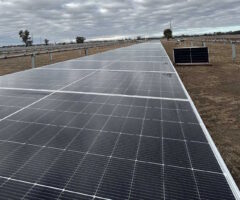Origin Energy has announced plans to double the size of the Eraring battery already under construction, adding a more than four-hour second stage to the facility to help soak up solar at the site of Australia’s largest coal generator.
The addition of a 240 megawatt (MW), 1030 megawatt hour (MWh) second stage will take the total size of the Eraring battery to 700 MW and 2103 MWh – pipped in size only by Neoen’s 2240 MWh Collie battery in Western Australia and Ark Energy’s proposed eight hour 2,200 MWh Myrtle Creek battery in NSW as the biggest in the country.
Origin is rapidly accelerating its investments in battery storage, having recently committed to the development of a 300 MW/650 MWh battery next to its Mortlake gas generator in Victoria, and striking tolling agreements for the offtake of the Supernode battery stage 1 and 2 near Brisbane, which amounts to 500 MW and 1560 MWh over two stages.
The company recently secured a deal to extend the operations of the 2,880 MW Eraring coal generator, for at least another two years and up to $450 million in payments from the NSW government, mainly because not enough replacement capacity had been built – either by Origin or any other party – to replace it.
“The second stage of the Eraring battery will be over four-hours duration and it will be capable of absorbing excess solar generation during the day to support reliable energy supply when needed, such as through the evening peak,” Greg Jarvis, the head of Origin’s energy supply and operations said in a statement.
“Eraring is a strategic site with high quality connection infrastructure. Confirmation of the second stage of the Eraring battery development is a key next step as we look to transform the site for the future so it can continue to support the energy transition.”
Origin has chosen Finnish technology group Wärtsilä as the technology provider – which is also supplying the first stage – while design and construction services to be provided by Enerven Energy Infrastructure (Enerven).
The company says the addition of the second stage will cost around $450 million, compared to more than $600 million for the slightly smaller first stage (in terms of megawatt hours).
That reflects some efficiencies from piggy-backing on an already started projects, but it also speaks to the big fall in battery storage technology costs, something confirmed in its recent first half results. “Battery material prices decreased during the second quarter of 2024,” it said.
Origin has revealed a number of other potential battery projects, including at its Darling Downs gas generator in Queensland, where it is mulling a 500 MW, 2,000 MWh battery, a 200 MW, 800 MWh battery at Templers Creek in South Australia, and two other “confidential” projects in Queensland and South Australia.
Eraring is Australia’s largest power station and supplies up to a quarter of electricity supply in New South Wales. Eraring is scheduled to close in August 2027, although it could stay open until 2029. The funding deal with the NSW government only extends to two years at this stage. It was due to close in August, 2025.
In a later statement, Wärtsilä – which has also provided the technology for AGL’s Torrens Island battery in South Australia – says the stage 2 Eraring battery will operate in Virtual Synchronous Machine (VISMA) mode, which enabling short circuit current capabilities such as reactive current, droop control, and synthetic inertia, to support grid stability and security.
“These capabilities, known as system strength support services, will be facilitated by Wärtsilä’s intelligent energy management system, the GEMS Digital Energy Platform,” it said.
It said stage two will be built with its Quantum High Energy next-generation energy storage system which includes advanced safety features, increased energy density and reduced maintenance requirements.
The second stage will be finished in 2027. The first stage is expected to be completed by the end of 2025.
See also Renew Economy’s Big Battery Storage Map of Australia for more information.








